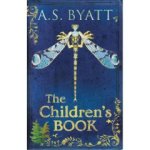 I’m afraid this review of The Children’s Book marks this reader’s goodbye to the new works of A.S. Byatt. That’s a hard decision to make — I have been reading her for more than 30 years and Possession was my desert island book for more than a decade. Byatt has always had a penchant for adult fairy tales and lengthy poems that made reading her a challenge — it has become more pronounced in her recent work and has now taken her into territory that I no longer want to explore.
I’m afraid this review of The Children’s Book marks this reader’s goodbye to the new works of A.S. Byatt. That’s a hard decision to make — I have been reading her for more than 30 years and Possession was my desert island book for more than a decade. Byatt has always had a penchant for adult fairy tales and lengthy poems that made reading her a challenge — it has become more pronounced in her recent work and has now taken her into territory that I no longer want to explore.
The Children’s Book is a sprawling, 615-page tome that opens in 1895 and extends through the Great War, closing off the reign of Queen Victoria and exploring the Edwardian Age in the process. It comes with both a political and cultural context as background framing material. The characters are all leftish artsy types. The political ones get involved in the Fabian Society and suffragette movements — Byatt explores a number of the splinters and factions that seem to be part of all left-wing movements. While the war is a part of the book, it gets pretty short shrift. The author devotes even more attention to the cultural side, the Arts and Crafts movement — most particularly potting, silverwork and productions featuring marionnettes — is explored in some detail.
And then there are the characters, dozens of them by my not so rigorous count:
— Olive and Humphrey Wellwood have seven children (and all nine of these stories are visited in the book). She is a famous writer of children’s and adult fairy-tales; he’s a banker who abandons that trade in favour of left-wing journalism.
— Major Prosper Cain is Special Keeper of Precious Metals at the South Kensington Museum, soon to become the Victoria and Albert. We meet him in the opening pages of the book; Olive is seeking advice on some details for one of her stories. We also meet his son and are soon introduced to his daughter (no wife in this family — he is a widower).
— Humphrey Wellwood’s brother, Basil, is a more conventional banker. Another wife and two more children are added to the character list from this family.
–Benedict Fludd, is a brilliant, tempermental potter with a wife and two daughters. His Dungeness studio also becomes a home to the potentially brilliant young Philip Warren, whose homeless sister also shows up to tend house.
When you add in a spinster sister or two, a family of German theatre artists, the compulsory Victorian vicar and a few other supporting characters who are necessary for the complicated plot, the total approaches three dozen. The adults are all potentially interesting — the problem is that in juggling such a large cast, the author has to desert them for lengthy stretches and none of them gets fully developed. And while a few coming of age story lines would be interesting, a dozen are not. It becomes difficult to figure out just which child is which as the book unfolds.
I know pretty much as much as I want to about the Fabians and the suffragettes and the book didn’t provide any revelations on that front. I confess to no inherent interest in the Arts and Crafts movement and again gained no insights that changed that.
There are fairy tales. Olive Wellwood writes an ongoing tale for each of her seven children (hence the title of the book) and excerpts from a number of them are included in the book — lengthy stretches of italic type that make the reading even more difficult. And Byatt has certainly not lost her talent for incredibly detailed description:
The parlour had dark green Morris and Co. wallpaper, spangled with scarlet berries, and a Morris set of spindly Sussex settle and chairs, with rush seats. There were woven rugs on a dark floor, a high shelves of orderly books. The possible tutor was already present, a young German, from Munich. Dr Joachim Susskind, in a threadbare suit, and wearing a red tie. Dr Susskind had flowing, hay-coloured, dry hair, and a fine waving moustache to go with it. His eyes were blue and mournful, not clear, glassy sky-blue like Dr Skinner’s but a clouded, faded blue, the diluted blue of an almost-white Small Blue butterfly, Tom thought. He looked mild and harmless.
Uncle. I give up.
I considered not reviewing this book because I don’t like writing reviews unless I can point to some readers who would like the book — and I suspect there are some out there for The Children’s Book. Byatt’s description of the Arts and Craft movement may have passed me by but others may be interested. I also suspect a parent who has gone through the coming of age process with a couple of children would also find more there than I did.
So, a fond goodbye to Ms. Byatt. I will continue to reread her earlier work with interest, but for me her oeuvre is now finished.